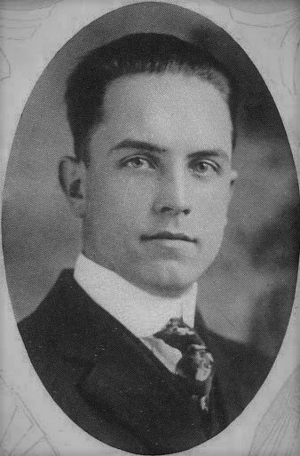Robert Henry Best facts for kids
Quick facts for kids
Robert Henry Best
|
|
|---|---|

Best in 1914
|
|
| Born | April 16, 1896 Sumter, South Carolina, U.S.
|
| Died | December 16, 1952 (aged 56) MCFP Springfield, Springfield, Missouri, U.S.
|
| Alma mater | Wofford College (1916) Columbia University School of Journalism (1922) |
| Occupation | Radio broadcaster, journalist, propagandist |
| Criminal status | Deceased |
| Conviction(s) | Treason (18 U.S.C. § 2381) (12 counts) |
| Criminal penalty | Life imprisonment |
| Military career | |
| Allegiance | United States |
| Service/ |
United States Army |
| Years of service |
1917 – 1920
|
| Unit | |
Robert Henry Best (born April 16, 1896 – died December 16, 1952) was an American journalist. He worked as a foreign correspondent in Europe. This was during the time between World War I and World War II. Later, he became a supporter of the Nazis. He was known for broadcasting Nazi propaganda during World War II. After the war, Best was arrested. He was sent back to the United States to face charges. In 1948, he was found guilty of treason. He was sentenced to spend the rest of his life in prison. Robert Best died in prison in 1952.
Contents
Early Life and Career
Robert Best was born in Sumter, South Carolina. His father was a Methodist minister. After finishing college at Wofford College in 1916, Best joined the United States Army Coast Artillery Corps in 1917. He served in the U.S. Army until 1920.
After his military service, he studied journalism. He graduated from the School of Journalism at Columbia University in 1922. He received a special scholarship. This scholarship allowed him to travel around Europe.
Life as a Journalist in Vienna
In 1923, Best moved to Vienna, Austria. He became a freelance news reporter there. He wrote for the United Press. He also wrote articles for famous newspapers and magazines. These included The New York Times and Time.
During the years between the two World Wars, Best reported on events in Central Europe. He was based in Vienna. Foreign journalists often met at a place called the Café Louvre. Best was a well-known person there. He was seen as a "Vienna institution." He was known for his unique style. He wore a wide-brimmed hat. He also spoke German poorly.
Joining the Nazi Propaganda Effort
Best started to support the Nazis after Nazi Germany took over Austria. This happened on March 12, 1938. This event was called the Anschluss.
In July 1941, the United Press fired him. This caused him to have money problems. He then tried to get a job with German State Radio. But he did not succeed right away.
Broadcasting for Germany
When the United States declared war on Nazi Germany in December 1941, Best was arrested. He was held with other American reporters. He decided to stay in Germany with his fiancée, Erna Maurer. She was an Austrian reporter. They got married in September 1942.
Best then got permission to go to Berlin. There, he met Werner Plack. Plack worked for the German Foreign Office's Radio Division. Plack hired Best to work as a commentator for German State Radio.
In April 1942, Best started working for the Reichs-Rundfunk-Gesellschaft. This was the German State Radio. He worked as a news editor and commentator. He broadcast talks to the United States. He used the secret name 'Mr. Guess Who'. His broadcasts were called 'B.B.B.' (Best's Berlin Broadcasts). He tried to keep his identity a secret.
His main targets for propaganda were President Franklin D. Roosevelt, Winston Churchill, and the Soviet Union. He also spoke against Jewish people. A writer named John Carver Edwards said that Best's broadcasts were very strong. He attacked Germany's supposed enemies.
On April 13, 1945, Best's radio program did not air. He left his apartment in Vienna. He forgot some personal papers there. These papers later helped to prove his guilt.
Arrest and Legal Proceedings
On July 26, 1943, Best and several other people were charged with treason. This happened in Washington, D.C. They were charged even though they were not present.
Best was arrested on January 29, 1946. British forces arrested him in Austria. They handed him over to the U.S. Army. He was then flown to the United States for his trial. He arrived in Massachusetts in December 1946.
The Treason Trial
Best's trial began on March 29, 1948, in Boston. He chose to act as his own lawyer. On April 16, 1948, Best was found guilty of 12 counts of treason. The jury specifically found that he had given "aid and comfort to the enemy." He admitted in court that he had made the broadcasts. He was sentenced to life in prison. He also had to pay a fine of $10,000.
Best tried to appeal his conviction in 1950. He again acted as his own lawyer. The appeal court upheld the decision of the lower court. Best then appealed to the U.S. Supreme Court. But the Supreme Court refused to review his case in February 1951.
Later Life and Death
Best served his prison sentence at a federal prison in Danbury, Connecticut. In August 1951, he was moved to a medical center for prisoners in Springfield, Missouri.
Robert Best died there on December 16, 1952. He passed away from a brain hemorrhage. He was buried in Pacolet, South Carolina. Another American who made Nazi propaganda, Herbert John Burgman, died at the same prison exactly one year after Best.
See also
- Donald S. Day
- Mildred Gillars

